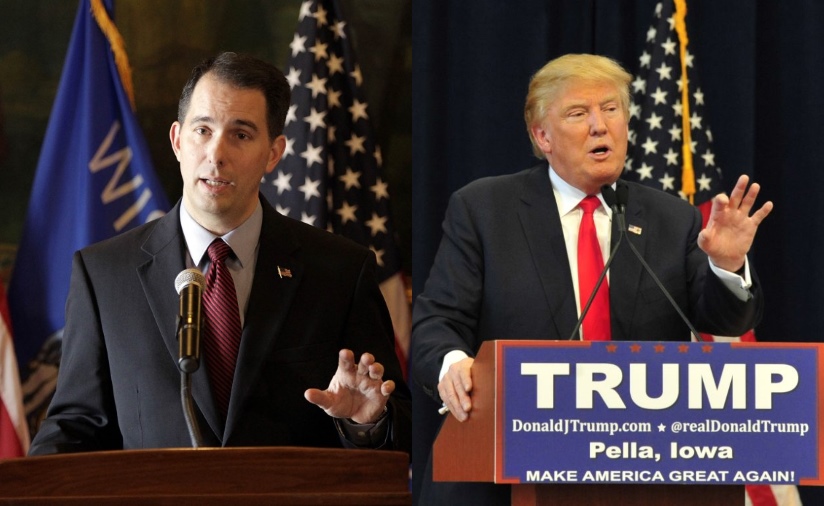Making Insurance Fake Again
Trump and Walker plans let health insurers end coverage of pre-existing conditions, sell junk policies.
The goal of the Affordable Care Act (ACA) is to provide universal access to medical care financed by private insurance companies competing in a regulated market. It is an alternative to single-payer plans and the “free-market” plans that prevailed before its passage. Prior to the ACA regulations, competitive forces led insurance companies to charge “experience-rated premiums,” which leads to the perverse result of pricing poor and sick people out of the market, and even to the denial of coverage.
Despite the ACA’s support for using private insurance companies to deliver health coverages, both President Trump and Governor Walker actively worked for its repeal. Now that their repeal efforts have failed, they are continuing their sabotage: the President is working to remove the Act’s regulations, while the Governor has dispatched Wisconsin Attorney General Schimel to lead a 20-state legal attack on the Act in Texas v. United States.
In unregulated health insurance markets, policyholders are grouped into pools of those who are estimated to pose roughly equal financial risk. Each policyholder in that pool is charged a premium that reflects the estimated average cost to the company. The greater that cost, the higher the premium. This method of premium-determination is called experience-rating.
In unregulated markets, health insurers compete on both price and coverage. Since pools with sicker and older people will experience more claims, their policies will be more expensive. So, in an effort to increase their profits, insurers will offer policies that cost less but which cover fewer maladies or which have exclusions for pre-existing health conditions.
The ACA Regulations
The basic idea behind the ACA is to harness the powerful forces of the market but guide them away from experience-rating toward provision of universal coverage. The structure of the plan was developed in 1993 by the Heritage Foundation, a conservative think tank. Heritage had identified four necessary market regulations:
- All policies must provide an essential benefits package in order to prevent people from buying lesser insurance at lower premiums.
- No one could be denied coverage or charged higher premiums because of a history of pre-existing health conditions.
- Known as the individual mandate, required that everyone must purchase insurance that meets ACA standards.
- Low-income people would receive assistance either through expansion of Medicaid or by subsidized purchase of insurance. Those who don’t get their ACA approved insurance through their employer must buy them on exchanges designed to assure compliance with the Act’s regulations. These exchanges are preferably set up and promoted by the states, but as a default can be run by the federal government.
The Sabotage
Trump realized the simplest way to sabotage the ACA was to eliminate the regulations, thereby permitting the market to revert to its natural state of experience-rated premiums. Step one was to eliminate the individual mandate, allowing people to wait until they are sick before signing up, thus discouraging both new and continuing enrollment in the program. Consequently, the average cost in the pools would rise, further discouraging participation.
Although the elimination of the mandate resulted in some drop-off in the rate of enrollment, the ACA remained popular because people with pre-existing conditions could still get coverage. Consequently, the program did not collapse fast enough to suit Trump. To speed things along, he recently introduced what he calls a patient-centered alternative, an Orwellian slogan intended to connote free and open market competition, unfettered by regulation. This “reform” allowed insurance companies to sell lower-cost, short-term policies that were not guaranteed renewable, had no requirement for an essential benefits package, and no requirement to cover those with pre-existing conditions
Americans rightfully admire the efficiency of the market for most of the goods and services they enjoy. However, Trump’s patient-centered option will pave the way for a return to pre-ACA days, when those with pre-existing health histories are either denied coverage or are charged very high experience-rated premiums, which will price many of them out of the market.
William L. Holahan is Emeritus Professor and former Chair of the Department of Economics at the UW-Milwaukee. Charles O. Kroncke served as Professor and Associate Dean of Business at UW-Madison as well as Dean of the School of Business at UW-Milwaukee and the School of Management at UT-Dallas. From August 2003 to May 2004, they served on, and Holahan chaired, the UW-System Search and Screen Committee during the search for a UWM chancellor.
Op-Ed
-
Wisconsin Candidates Decry Money in Politics, Plan to Raise Tons of It
 Dec 15th, 2025 by Ruth Conniff
Dec 15th, 2025 by Ruth Conniff
-
Trump Left Contraceptives to Rot; Women Pay the Price
 Dec 8th, 2025 by Dr. Shefaali Sharma
Dec 8th, 2025 by Dr. Shefaali Sharma
-
Why the Common Council’s Amended Budget is Good Policy for Milwaukee
 Nov 20th, 2025 by Alds. Marina Dimitrijevic and Russell W. Stamper, II
Nov 20th, 2025 by Alds. Marina Dimitrijevic and Russell W. Stamper, II






















50% of personal bankruptcies in the US are due, in the main, to health care costs. 75% of those folks are people who actually have health insurance. This will only make matters worse.
(Source: Griftopia, by Matt Taibbi)